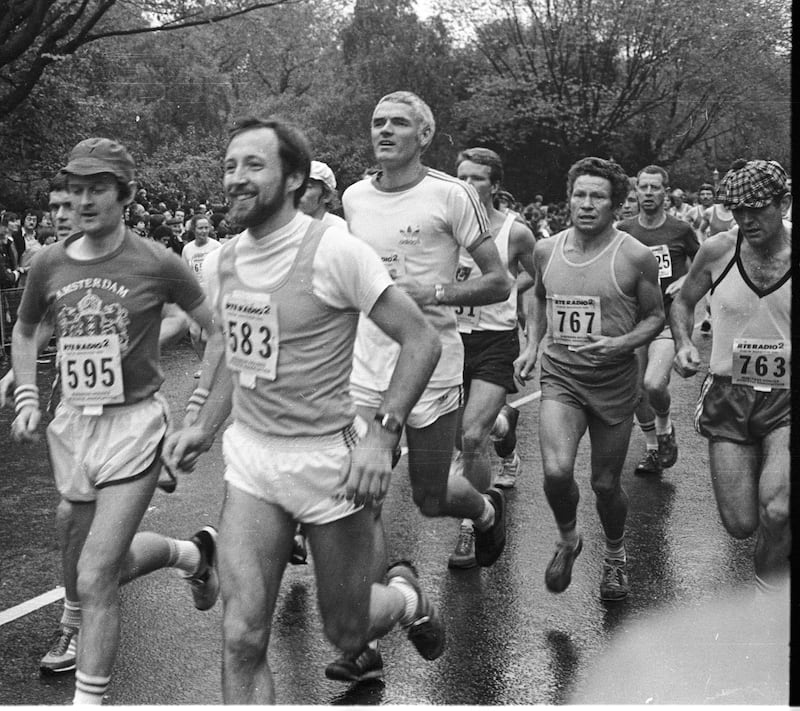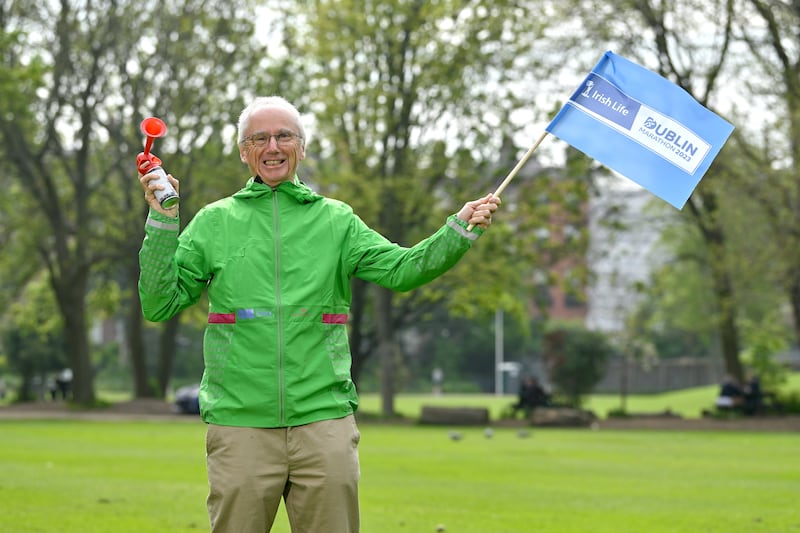It was somewhere around the 25-mile mark when John Treacy took one last glance over his shoulder. Crowds of people lined both sides of the road, and no one else was within sight. In front of him or behind.
Only the final flat stretch towards O’Connell Street, then the finish line outside the GPO, where about two hours earlier he’d set off with thousands of other runners in bright October sunshine.
“Got this in the bag,” Treacy said under his own calm breath. “I’ve run this last mile in my sleep.”
A second or two later, he felt a sudden bolt of pain shoot down his right hamstring, a telltale sign something might be about to cramp. At age 36 he’d known pain like this before, and it hadn’t ended well.
READ MORE
“Oh s**t ...” he said. If anyone else had been running alongside they might have taken some encouragement.
Treacy had made it clear the 1993 Dublin Marathon would be his last. A sort of homecoming, it was the chance to go out in style and on his own terms. He absolutely backed himself to win, and everyone else did too.

Looking at his watch, he was still on around 2:14 pace, and briefly smiled when reminded of the World Cross-Country Championships in Limerick, way back in 1979. He’d felt sure about winning win that too, starting into penultimate lap, then slipped sideways in the mud and on to his backside.
“Slow down, don’t get too cocky!”
He’d gone clear in Dublin between miles 19 and 20, so gently backed off, hardly noticeable to anyone watching, glad at that point there wasn’t anyone else running alongside, still chasing the win or any podium position. As there was in his first marathon, back in 1984, when on a steaming hot August evening in Los Angeles the greatest-ever assembled field of Olympic marathon runners was eventually reduced to three: Treacy, Carlos Lopes from Portugal, and Britain’s Charlie Spedding.
“Where am I in the race? How far is there left to go?” were Treacy’s only thoughts in that moment.
He’d started that marathon at age 27 under no expectations at all, other than his own, determined he could still make an impact despite finishing ninth in the 10,000m having also raced his heat days before. With names such as Rob de Castella, Alberto Salazar, Toshihiko Seko, Juma Ikangaa and Rod Dixon starting alongside him that day, they might well have looked at Treacy and thought, “Sure we’ll beat him anyway.”
In the end Treacy beat them all except for Lopes, whose utterly masterful run and victory in 2:09:21, at age 37, earned him Olympic gold. Treacy’s debut time of 2:09:56 to win the silver medal would have been good enough to win gold in 1988, and also in 1992, in 1996, in 2000 and in the 2004 Olympic marathon.
He improved his best to 2:09:15 when finishing third in Boston in 1988. That same year he was third in New York, was third again in Boston in 1989, then finished second in the Tokyo Marathon in 1990. It would be eight years after winning his Olympic silver before he won his first marathon, suitably back in Los Angeles, in 1992.
A year on from that, and Dublin was his chance to end his marathon career on a winning note, and all Treacy needed to do was finish it out and make sure of it. Suitably warned perhaps by that ageing hamstring, he simply relaxed back into a calm rhythm. Once he turned on to O’Connell Street, the sight and sound of the Dublin crowd carried him home.
Finishing with a smile and casual raising of his arms, his time of 2:14:40 left him over a minute clear of John Griffin in second place, and wouldn’t be bettered by any Irish runner in Dublin until 2019.

Like all original and best stories about the Dublin Marathon, it begins with Noel Carroll. Nobody cared more about the positives and publicity around the event, which Carroll cofounded in 1980, and he practised what he preached, also running that same first year.
By 1992 the Dublin Marathon numbers were running dangerously low: from a then peak of 8,748 finishers in 1982, the number of finishers dropped to a still all-time low of 2,414. Sponsorship interest was running low too. That 1992 race had gone ahead without any sponsor, and if Golden Pages hadn’t stepped in late the 1993 Dublin Marathon would never have happened.
A few months out, Carroll still needed something fresh to promote the 1993 event. Which is when the 1984 Olympic silver medal winner came to mind, and straight away Carroll picked up the phone.
“Hello, is that John Treacy?”
When we meet in Dublin over coffee, Treacy recalls this conversation like it was yesterday, not 30 years ago; how Carroll’s famously persuasive charm convinced him to run one more classic distance.
“Any telephone call like that Noel was always in upbeat mood,” Treacy says now, “asking me was I fit, asking about the family. Then you knew he was going to ask you for something else. Whether that was for Goal, which he helped a lot with, Noel was always on for something.
“He’d read in an interview somewhere that said I was finished with the marathon, and he just said, ‘You still need to run Dublin, it will be your last marathon, you have to come home, run here ... it would be such a shame not to.’
“Noel was such a convincing personality like that, you’d nearly always come round to his way of thinking. So I thought about it for maybe a day, then rang him back and said yes.”
At that point Treacy was still living in Providence, Rhode Island, with his wife Fionnuala and four young children. He’d just turned 36, certainly not old by marathon running standards, given Lopes won that LA Olympic marathon at 37, then broke the world record the year after.
“Barcelona in 1992 was my third Olympic marathon, my fourth Olympics, and I’d suffered a bit in that one,” Treacy says (he finished 51st). “After winning LA earlier in 1992, I went back again in March of 1993, it didn’t go great. I finished fifth, in 2:17, a very, very hot day, and suffered a bit in that one too.
“By then I was thinking, ‘that’s it with the marathon,’ I’ll go back and run a few track races, shorter road races, just enjoy myself. With the marathon, you need to get ready for months. I’d go down to Arizona or Albuquerque, away from the family, do all this work, and then sometimes the whole thing just blows up in your face.
Even if Carroll briefly changed that mindset, Treacy’s approach for Dublin would be different. He dropped the specific marathon training, racing 10km, competed in a half-marathon in Zurich (finishing third in 1:02:57), then, on October 10th, he ran 46.25 for 10 miles in the Portsmouth Great South Run, still the Irish record.
“I knew I was in decent shape then. Then I come home the week before, and same old story. As soon as I get off the plane, I’d nearly always get a cold. I felt sick as a dog for a couple of days, was still dying on the Thursday. But there was no way I could pull out of Dublin, with all this expectation around, all Noel’s talk of me winning my last marathon here.
“I was feeling better on the Sunday. The whole plan was to take it as easy as possible, run within myself, then make one big move. And for me, I really enjoyed Dublin, got a fantastic cheer the whole way around, you’d hear things like ‘thanks for the memories’, and that meant a great deal.
“I was back in that zone, just loving to race again. Just like at the beginning of my running career, things had come full circle like that. Running and racing on impulse and instinct, back to my roots really.”
Sadly, five years later, Carroll died suddenly following a run in Belfield, three days before the 1998 Dublin Marathon.

Looking at Treacy now, he has lost little of his running physique, and still gets out for a few “very slow” runs a week. But, true to his word, Dublin was his last marathon.
He continued to race shorter distances for another year, and, just six weeks after winning Dublin, was back in his native Waterford to win another National Inter-County Cross-Country title.
Then he ran his last race, billed as such, five miles on the roads around Waterford city in 1995, which Treacy duly won, and among those making the trip to pay tribute were Lopes and Spedding.
Lots of elite runners are either slow to go into retirement, or else soon reverse their decision once they do. But for Treacy there was no turning back. No temptation, no regrets either – a rare thing in any competitive sport.
“I was fulfilled, simple as that. For me, when I did retire, one of the great reliefs was that I didn’t have to worry about catching a cold any more.
“When you’re training for a marathon like that, you’re also carrying zero weight, you’re skin and bone, feeling cold all the time. It was okay training in Arizona. But whenever I’d come home here, I’d be freezing my ass off.
“I’d be wearing the jumper and long overcoat, and everyone else would be walking around in a T-shirt. One of the best things about the first few weeks in my retirement was putting on a stone in weight.”
Still, his decision to retire with possibly a few more racing years left in him, or at least one more marathon, surprised some people. “I remember talking to my sponsor, New Balance, told them I was done competing, and they looked at me and said, ‘what?’ They couldn’t believe it. Runners tend to fade away, or someone will retire them.
“I’d made up my mind we were coming back to Ireland, that’s where we wanted to bring up our four children, that was all decided. Which is what we did, moved home within a year or two, and settled into another life here.”
With that our conversation turns to Sunday’s Irish Life Dublin Marathon, which Treacy has been invited to start. In 2019, Stephen Scullion did improve on Treacy’s 1993 winning time of 2:14:40, finishing second in 2:12:01. A year later in London, Scullion clocked 2:09:49, and, given Treacy’s best of 2:09:15 was clocked on the net-downhill gradient course of Boston, Scullion’s time is the official Irish record.
Last year’s top Irish finisher was Martin Hoare from Kildare, who finished seventh overall in 2:20:21, at age 35. Treacy remains hopeful. “I do think it will come back around again. But first of all, you have to have a really good 5,000m runner, a 10,000m runner, who is moving up.
“Are they still doing the hard training? I don’t really know. The big thing for me, whenever I was preparing for a marathon, was to go away for three or four weeks, down to Phoenix or Albuquerque, creating a little training camp of my own, essentially, that environment where you could just concentrate on the training all day.
“And training with people in the same mindset and environment. So I’d be running 120 miles a week, still doing two sessions on the track. But not racing at all during that period, just building up strength and endurance.
“Now, we might be waiting another 10 or 20 years, but it will happen again. I’d be fully convinced we’ll have another world-class marathon runner in due course.”
Maybe, but chances are we won’t ever have another John Treacy.
















